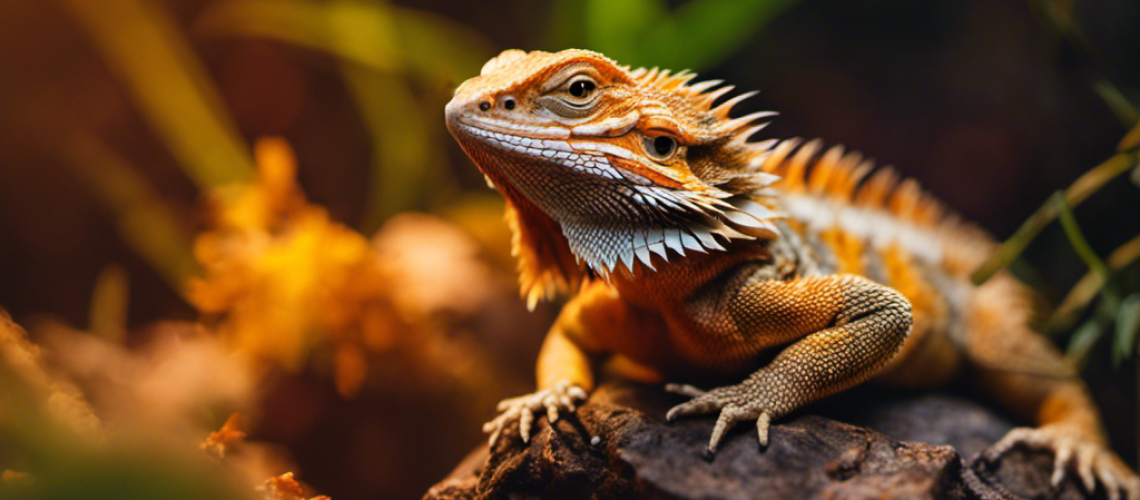Bearded dragons are a popular exotic pet, but they require careful attention to their environment in order to maintain optimal health. Owners must be aware of the temperature requirements for bearded dragons and how long they can go without regulated heat before facing potential health issues.
This article will discuss temperature requirements for bearded dragons, effects of prolonged cold on them, providing necessary heat, signs of health issues in them, and how to tell when your bearded dragon needs heat.
Key Takeaways
- Bearded dragons require optimal temperatures ranging from 30-35°C (86-95°F) for their wellbeing.
- Heat sources such as basking lamps, ceramic bulbs, and heat mats are necessary to provide adequate heat.
- Regular monitoring of temperatures is crucial to ensure the dragons’ health and prevent issues.
- Prolonged exposure to cold temperatures can have negative implications, so preventive measures should be taken.
Temperature Requirements for Bearded Dragons
The optimal temperature range for a bearded dragon’s environment is approximately 30-35°C (86-95°F). Heat sources such as basking lamps, ceramic bulbs, and heat mats can help to maintain this ideal range.
It is important that these sources are regularly monitored to ensure the temperatures remain within the specified range. If not, health issues can arise due to inadequate temperatures.
With appropriate heating sources in place, bearded dragons have the freedom they need for optimum wellbeing.
Effects of Prolonged Cold on Bearded Dragons
Prolonged exposure to cold temperatures can have negative implications for bearded dragons. Monitoring health and ensuring proper diet is key in order to protect them from adverse effects of prolonged cold.
- Temperature should be monitored regularly
- Humidity levels should also be checked frequently
- Supplements such as vitamins and calcium may need to be increased.
Providing Necessary Heat for Bearded Dragons
Proper heating is essential for bearded dragons to maintain adequate health and wellbeing. Temperature gradients are necessary for proper heat regulation, with warmer basking areas and cooler retreats. It is generally recommended that the temperature at basking area should be around 95-105°F (35-40°C).
A temperature drop of 10-15°F (5-8°C) before nightfall is normal, as well as a decrease in humidity. To ensure these needs are met, it is important to provide appropriate heating sources such as ceramic or infrared heat emitters, UVA/UVB bulbs, and thermostats for consistent temperatures throughout their enclosure.
Signs of Health Issues in Bearded Dragons
Signs of potential health issues in bearded dragons can include:
- Changes in behavior, such as becoming lethargic or inactive
- Loss of appetite, due to sweltering heat or other causes
- Shedding skin more often than usual.
These warning signs should be taken seriously and prompt a visit to the vet for diagnosis and treatment.
How to Tell When Your Bearded Dragon Needs Heat
It is important to monitor bearded dragons for indications of needing heat, such as changes in activity levels or behavior. Basking behaviors, like sitting at the top of their enclosure, are often signs that they need more heat.
A properly heated environment should have a basking area with temperatures between 95 and 110 degrees Fahrenheit. Heat lamps can be used to create these temperatures; they should also be given 12-14 hours of light per day.
Keeping track of your pet’s temperature is key to ensure its health and wellbeing.
Frequently Asked Questions
What Is the Optimal Temperature for a Bearded Dragon?
The optimal temperature for a bearded dragon is between 80 and 88°F (26.6-31.1°C). Heat sources should be used to regulate the temperature. UVB lighting is important to provide necessary vitamin D3 and prevent health issues.
How Often Should I Check the Temperature of My Bearded Dragon’s Environment?
To ensure optimal health, bearded dragons require consistent temperatures that should be monitored regularly. Adjusting temperatures when needed will promote a healthy environment and prevent potential disease or injury. It is important to check the temperature of your dragon’s environment frequently for best results.
How Can I Provide a Safe and Comfortable Heat Source for My Bearded Dragon?
To provide a safe and comfortable heat source for a bearded dragon, one can use heat lamps, thermostats, or heating mats. Heat lamps should be used with caution as they can easily overheat the environment. Thermostats are helpful in regulating temperatures when combined with other heat sources such as heating mats. Heating mats should be placed away from drafty areas and monitored regularly.
How Can I Tell if My Bearded Dragon Is Suffering From Cold-Related Health Issues?
Cold-related health issues in bearded dragons may be indicated by improper temperature regulation or lack of sufficient heat. To reduce the risk of these issues, regular monitoring and adjustment of environmental temperature is necessary to ensure proper heat regulation.
How Long Can My Bearded Dragon Go Without Heat Before It Becomes a Health Issue?
Bearded dragons require regular temperature adjustments to prevent hibernation risks. Without heat, health issues can arise in as little as 24 hours. Therefore, it is important to ensure a consistent temperature for bearded dragons at all times.
Conclusion
Bearded dragons require a specific temperature range in order to stay healthy. Prolonged cold can have serious effects on the health of bearded dragons, including dehydration and organ failure. Providing adequate heat is essential for keeping them healthy and comfortable.
By monitoring their behavior and physical appearance, owners can tell when their dragon needs additional heat. Properly providing the necessary warmth ensures that the bearded dragon remains happy and healthy.






